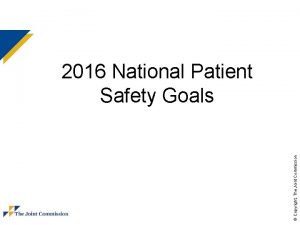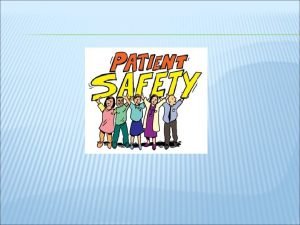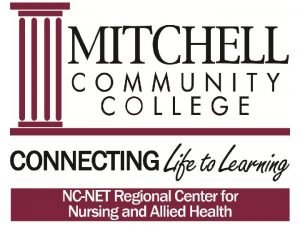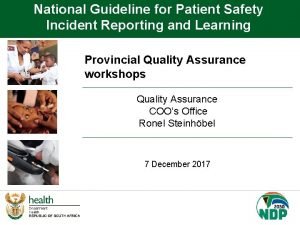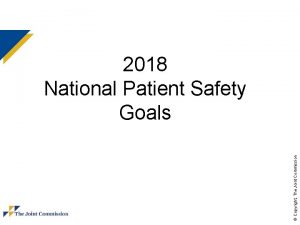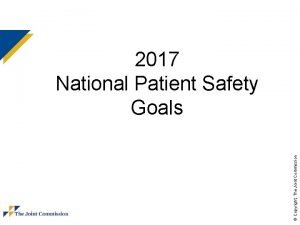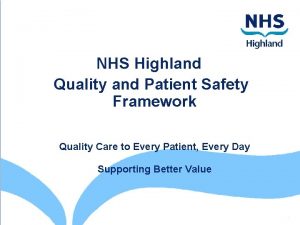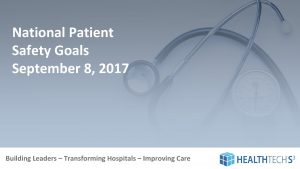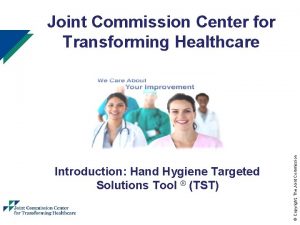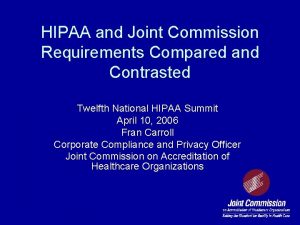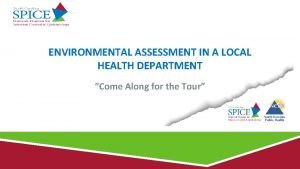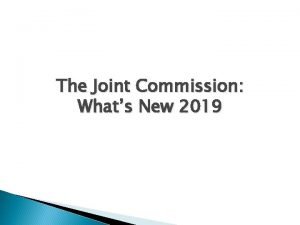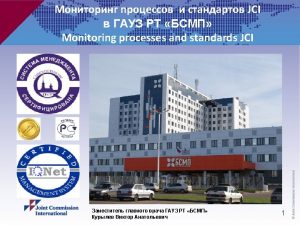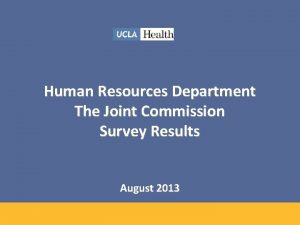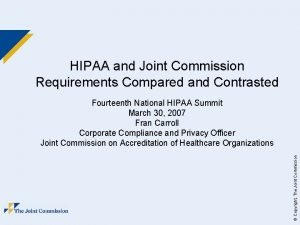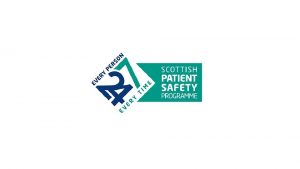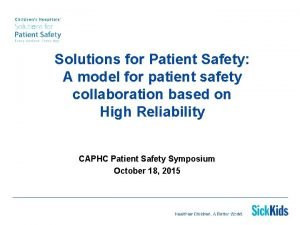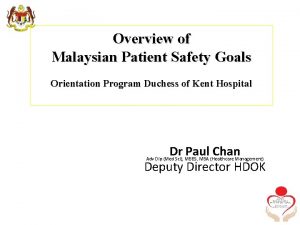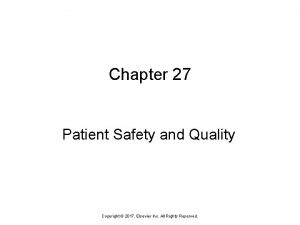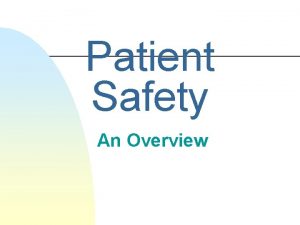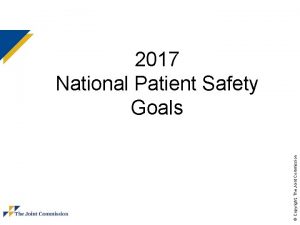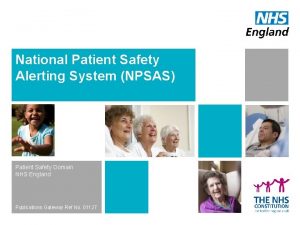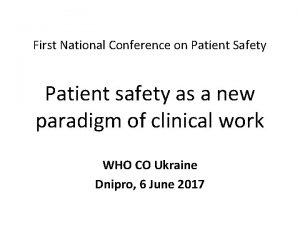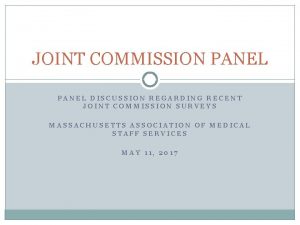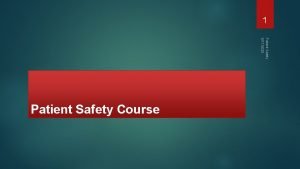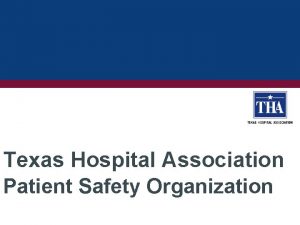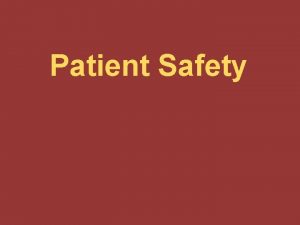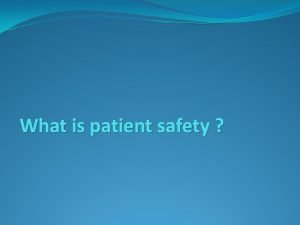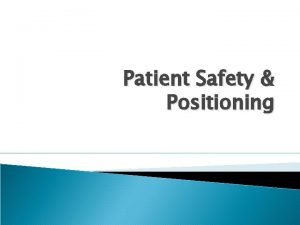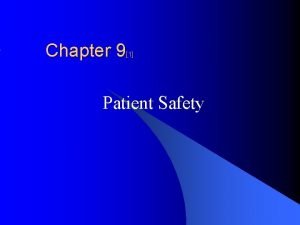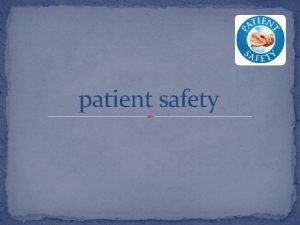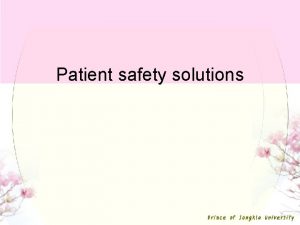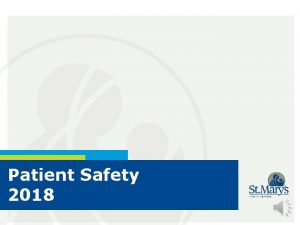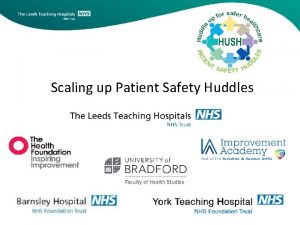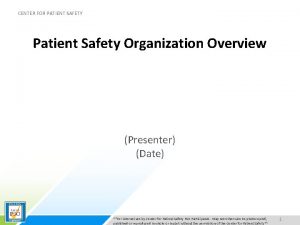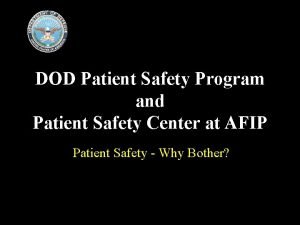Copyright The Joint Commission 2013 National Patient Safety
































- Slides: 32

© Copyright, The Joint Commission 2013 National Patient Safety Goals

Background z The National Patient Safety Goals (NPSGs) were established in 2002 to help accredited organizations address specific areas of concern in regards to patient safety z The Patient Safety Advisory Group advises The Joint Commission on the development and updating of NPSGs 2013 National Patient Safety Goals - Pg. 2 © Copyright, The Joint Commission z The first set of NPSGs was effective January 1, 2003

Patient Safety Advisory Group z Advises The Joint Commission how to address emerging patient safety issues in NPSGs, Sentinel Event Alerts, standards and survey processes, performance measures, educational materials, and Center for Transforming Healthcare projects 2013 National Patient Safety Goals - Pg. 3 © Copyright, The Joint Commission z Comprised of a panel of widely recognized patient safety experts including nurses, physicians, pharmacists, risk managers, clinical engineers, and other professionals with hands-on experience in addressing patient safety issues in a wide variety of health care settings

Update to NPSG on Reconciling Medication z The NPSG on reconciling medication information (formerly NPSG. 08. 01 - 08. 04. 01, now NPSG. 03. 06. 01) was streamlined and focused to place a spotlight on critical risk points in the medication reconciliation process z NPSG. 03. 06. 01 replaces Goal 8 (08. 01, 08. 02. 01, 08. 03. 01 and 08. 04. 01) and its related elements of performance z NPSG. 03. 06. 01 became effective July 1, 2011 2013 National Patient Safety Goals - Pg. 4 © Copyright, The Joint Commission z The NPSG was revised based on input from the field about implementation difficulties related to the 2009 version of the NPSG which was too prescriptive and detailed

Changes for 2013 z The NPSG focusing on catheterassociated urinary tract infection (CAUTI) was introduced in 2012 with a phased implementation 2013 National Patient Safety Goals - Pg. 5 © Copyright, The Joint Commission z Full implementation is expected in 2013

Patient Identification Goal 1: 2013 National Patient Safety Goals - Pg. 6 © Copyright, The Joint Commission Improve the accuracy of patient identification.

Patient Identification z NPSG. 01. 01: Use at least two patient identifiers when providing care, treatment and services. 2013 National Patient Safety Goals - Pg. 7 © Copyright, The Joint Commission • Applies to: Ambulatory, Behavioral Health Care, Critical Access Hospital, Home Care, Hospital, Lab, Long Term Care, Office-Based Surgery

Patient Identification z NPSG. 01. 03. 01: Eliminate transfusion errors related to patient misidentification. 2013 National Patient Safety Goals - Pg. 8 © Copyright, The Joint Commission • Applies to: Ambulatory, Critical Access Hospital, Office-Based Surgery

Improve Communication Goal 2: 2013 National Patient Safety Goals - Pg. 9 © Copyright, The Joint Commission Improve the effectiveness of communication among caregivers.

Improve Communication z NPSG. 02. 03. 01: Report critical results of tests and diagnostic procedures on a timely basis. 2013 National Patient Safety Goals - Pg. 10 © Copyright, The Joint Commission • Applies to: Critical Access Hospital, Lab

Medication Safety Goal 3: 2013 National Patient Safety Goals - Pg. 11 © Copyright, The Joint Commission Improve the safety of using medications.

Medication Safety z NPSG. 03. 04. 01: Label all medications, medication containers, and other solutions on and off the sterile field in perioperative and other procedural settings. 2013 National Patient Safety Goals - Pg. 12 © Copyright, The Joint Commission • Applies to: Ambulatory, Critical Access Hospital, Office Based Surgery

Medication Safety z NPSG. 03. 05. 01: Reduce the likelihood of patient harm associated with the use of anticoagulant therapy. 2013 National Patient Safety Goals - Pg. 13 © Copyright, The Joint Commission • Applies to: Ambulatory, Critical Access Hospital, Long Term Care

Medication Safety z NPSG. 03. 06. 01: Maintain and communicate accurate patient medication information. 2013 National Patient Safety Goals - Pg. 14 © Copyright, The Joint Commission • Applies to: Ambulatory, Behavioral Health Care, Critical Access Hospital, Home Care, Hospital, Long Term Care, Office-Based Surgery

Health Care-Associated Infections Goal 7: 2013 National Patient Safety Goals - Pg. 15 © Copyright, The Joint Commission Reduce the risk of health care-associated infections.

Health Care-Associated Infections • Applies to: Ambulatory, Behavioral Health Care, Critical Access Hospital, Home Care, Hospital, Lab, Long Term Care, Office-Based Surgery 2013 National Patient Safety Goals - Pg. 16 © Copyright, The Joint Commission z NPSG. 07. 01: Comply with either the current Centers for Disease Control and Prevention (CDC) hand hygiene guidelines or the current World Health Organization (WHO) hand hygiene guidelines.

Health Care-Associated Infections z NPSG. 07. 03. 01: Implement evidencebased practices to prevent health careassociated infections due to multidrugresistant organisms in acute care hospitals. 2013 National Patient Safety Goals - Pg. 17 © Copyright, The Joint Commission • Applies to: Critical Access Hospital, Hospital

Health Care-Associated Infections z NPSG. 07. 04. 01: Implement evidencebased practices to prevent central lineassociated bloodstream infections. 2013 National Patient Safety Goals - Pg. 18 © Copyright, The Joint Commission • Applies to: Critical Access Hospital, Long Term Care

Health Care-Associated Infections z NPSG. 07. 05. 01: Implement evidencebased practices for preventing surgical site infections. 2013 National Patient Safety Goals - Pg. 19 © Copyright, The Joint Commission • Applies to: Ambulatory, Critical Access Hospital, Office-Based Surgery

Health Care-Associated Infections z NPSG. 07. 06. 01: Implement evidencebased practices to prevent indwelling catheter-associated urinary tract infections (CAUTI). (Note: This NPSG is not applicable to pediatric populations. Research resulting in evidence-based practices was conducted with adults, and there is not consensus that these practices apply to children. ) 2013 National Patient Safety Goals - Pg. 20 © Copyright, The Joint Commission • Applies to: Critical Access Hospital, Hospital.

Reduce Falls Goal 9: 2013 National Patient Safety Goals - Pg. 21 © Copyright, The Joint Commission Reduce the risk of patient harm resulting from falls.

Reduce Falls z NPSG. 09. 02. 01: Reduce the risk of falls. 2013 National Patient Safety Goals - Pg. 22 © Copyright, The Joint Commission • Applies to: Home Care, Long Term Care

Pressure Ulcers Goal 14: 2013 National Patient Safety Goals - Pg. 23 © Copyright, The Joint Commission Prevent health care-associated pressure ulcers (decubitus ulcers).

Pressure Ulcers z NPSG. 14. 01: Assess and periodically reassess each resident’s risk for developing a pressure ulcer and take action to address any identified risks. Applies to: Long Term Care 2013 National Patient Safety Goals - Pg. 24 © Copyright, The Joint Commission •

Risk Assessment Goal 15: 2013 National Patient Safety Goals - Pg. 25 © Copyright, The Joint Commission The organization identifies safety risks inherent in its patient population.

Risk Assessment z NPSG. 15. 01: Identify patients at risk for suicide. 2013 National Patient Safety Goals - Pg. 26 © Copyright, The Joint Commission • Applies to: Behavioral Health Care, Hospital (applicable to psychiatric hospitals and patients being treated for emotional or behavioral disorders in general hospitals)

Risk Assessment • Applies to: Home Care 2013 National Patient Safety Goals - Pg. 27 © Copyright, The Joint Commission z NPSG. 15. 02. 01: Identify risks associated with home oxygen therapy, such as home fires.

Universal Protocol for Preventing Wrong Site, Wrong Procedure, Wrong Person Surgery™ z UP. 01. 01: Conduct a preprocedure verification process. 2013 National Patient Safety Goals - Pg. 28 © Copyright, The Joint Commission • Applies to: Ambulatory, Critical Access Hospital, Office-Based Surgery

Universal Protocol for Preventing Wrong Site, Wrong Procedure, Wrong Person Surgery™ z UP. 01. 02. 01: Mark the procedure site. 2013 National Patient Safety Goals - Pg. 29 © Copyright, The Joint Commission • Applies to: Ambulatory, Critical Access Hospital, Office-Based Surgery

Universal Protocol for Preventing Wrong Site, Wrong Procedure, Wrong Person Surgery™ z UP. 01. 03. 01: A time-out is performed before the procedure. 2013 National Patient Safety Goals - Pg. 30 © Copyright, The Joint Commission • Applies to: Ambulatory, Critical Access Hospital, Office-Based Surgery

For more information… z Questions can be sent to the Standards Interpretation Group at (630) 792 -5900 or via the Standards Online Question Submission Form 2013 National Patient Safety Goals - Pg. 31 © Copyright, The Joint Commission z The National Patient Safety Goals for each program and more information are available on The Joint Commission website at www. jointcommission. org

z. Why are NPSG’s important? z. Why are they necessary? z. Does this make you feel safe? Why and in what way? z. How will you as a healthcare student implement these goals? Give an example? 2013 National Patient Safety Goals - Pg. 32 © Copyright, The Joint Commission Question
 National patient safety goals 2016
National patient safety goals 2016 2013 hospital national patient safety goals
2013 hospital national patient safety goals National patient safety goals 2012
National patient safety goals 2012 Patient safety incident definition
Patient safety incident definition Q2 national patient safety goals
Q2 national patient safety goals National patient safety goals 2017
National patient safety goals 2017 National patient safety framework
National patient safety framework 2018 national patient safety goals
2018 national patient safety goals Mbti personal impact report
Mbti personal impact report Patient 2 patient
Patient 2 patient Secondary commission 1952-53
Secondary commission 1952-53 Graduated commission examples
Graduated commission examples Jcaho nursing
Jcaho nursing Targeted solutions tool
Targeted solutions tool Joint commission accreditation standards
Joint commission accreditation standards Joint commission sink splash zone
Joint commission sink splash zone Niaho standards
Niaho standards Whats the joint commission
Whats the joint commission Jci standards
Jci standards Joint commission survey results
Joint commission survey results Joint commission hipaa
Joint commission hipaa Break joint lamb
Break joint lamb Hyaline cartilage vertebrae
Hyaline cartilage vertebrae Permanent joint types
Permanent joint types Joint venture accounting journal entries
Joint venture accounting journal entries Lamb grading chart
Lamb grading chart Saddle joint example
Saddle joint example National copyright
National copyright Essentials of safe care
Essentials of safe care Solutions for patient safety
Solutions for patient safety Malaysia patient safety goal
Malaysia patient safety goal Learn from patient safety events
Learn from patient safety events A nurse floats to a busy surgical unit
A nurse floats to a busy surgical unit
